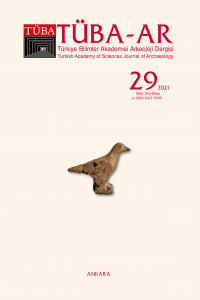JAFAR ABAD VE TU ALİ SOFLA KURGAN KAZILARINDA ELE GEÇEN HAYVAN KEMİK KALINTILARI, KUZEYBATI İRAN 2010 VE 2013 SEZONU
Mezarlardan ele geçen Arkeoloji veriler çok değerli bilgiler vermektedir. En önemlisi göçebe halkların bir çokyönlerini aydınlatmaktadır. Avrasya Atlı Göçebe Savaşçılarının önemli mimarisi olan Kurgan mezarlarındaele geçen Arkeolojik verilerin ışığında ise bu kavimin hakkındaki sosyal tabakalanmanın oluşumu ve nedenleri,etnografya, ekonomi, kronoloji, ölü gömme gelenekleri, diyetsel çeşitlilik ve ilaveten bir çok karanlık noktaaydınlatılmaktadı. Bu çalışmada Kuzey Batı Iran’da Araz Nehir kıyısının güne kısmında yer alan Jafar Abad ve TuAli Sofla Kurganları’ndan ele geçen kemik buluntular üzerinde inceleme ve değerlendirme yapılacaktır. Ele geçenkemik buluntuların araştırma sonucunda hayvan gömüleri ve hayvan’dan yapılmış eserler olarak iki gurub olaraktespit edilmiştir.
Anahtar Kelimeler:
Avrasya Atlı Göçebe Savaşçıları, Kurgan, Hayvan Gömüleri, Kemik Eserler
ANIMAL REMAINS EXCAVATED AT JAFAR ABAD AND TU ALİ SOFLA KURGANS, NORTHWEST IRAN 2010 AND 2013 SEASONS
Included among the coherent archaeological data that gives archaeologists the best insight into intangible facets of past cultures, in particular nomadic groups, are burials and mortuary customs. Study of kurgans and associated material culture will shed a blaze of light on the chronology, ethnography, social classes, subsistence system and dietary diversity of the so-called Eurasian Warrior Nomads, bringing further aspects of their culture into light. The present paper explored the animal remains attested in the kurgans of Jafar Abad and Tu Ali Sofla in the southern Aras River Basin of Northwest Iran. Thus, the animal burials and the grave goods made of animal bones and marine animals, which account for a major part of the recovered assemblages, are presented and discussed here
Keywords:
Eurasian Nomadic Warrior Groups, Kurgans, Animal Burials, Bone Tools,
___
- IRAVANI GHADIM, F. 2011a Jafar Abad VIII. Kurgan Kazıları, Kuzeybatı İran, Karadeniz’den Fırat’a Bilgi Üretimi, Önder Bilgi’ye Armağan Yazıları (Eds. A.Öztan / Ş.Dönmez) Ankara: 119-216.
- IRAVANI GHADIM, F. 2011b “Kaplumbağa Kabuğundan Müzik Aleti”, NTV Tarih 26: 14.
- IRAVANI GHADIM, F. 2012 “The Culture of the Nomadic Tribes of Eurasia, Northwest Iran Case Study: The Jafar Abad Kurgans”, International Congress Society of South Asian Archaeology (4SOSAA) at the University of Sistan Baluchestan, Iran, Zahedan: 64.
- IRAVANI GHADIM, F. 2013a “Excavations in Jafar Abad: Preliminary Report of Kurgan No V”, Lux et Ponto Euxino Studies Presented in Honour of Sumer Atasoy. (Ed. Ş. Dönmez) Ankara: 217-236.
- IRAVANI GHADIM, F. 2013b “Eurasian Nomadic Warriors of the Firest And Second Millennium BC In the Aras River Basin: The Case of the Jafar Abad And Too Ali Sofla Kurgans”, Azerbaijan National Academy of Sciences Institute of Archaeology and Ethnography.International Scientific Conference, Archaeology and Ethnography of Azerbaijan in the Independent Period, Baku, Azerbaijan: 119.
- IRAVANI GHADIM, F. 2014 “Jafar Abad Kurgan No IV”, Essays in Honour of Veli Sevin A Life Immersed in Archaeology (Ed. A. Özfırat) İstanbul: 87-107.
- IRAVANI GHADIM, F. 2015 a “Jafar Abad Kurgans Excavations (2010 Season)”, International Symposium on East Anatolia-South Caucasud Cultures, Erzrum, Turkey: 89-111.
- IRAVANI GHADIM, F. 2015 b “Eurasian Nomadic Warriors of the First and Second Millennium BC in the Aras River Basin: The Case of the Jafar Abad And Tu Ali Sofla Kurgans, 20th Annual Meeting of the European Association of Archaeologists, 10-14 September 2014 Istanbul | Turkey: 111.
- IRAVANI GHADIM, F. 2018 “The Role of Domestic Animals in the Life of Eurasian Nomadic Warrior Groups in Light of Recent Archaeological Evidence”, TÜBA-AR 22: 19-33
- JONES-BLEY, K. 2000 “Sintashta Burials and Their Western European Counterparts Kurgans, Ritual Sites, and Settlements Eurasian Bronze and Iron Age”, Part Iii.Interpretations of Eurasian Archaeology the Bronze Age the Eurasian Steppes. Bar International Series 890 Oxford: 126-134.
- KENT HANKS, B. 2003 Human-Animal Relationship in the Eurasian Steppe Iron Age: An Exploration in to Social, Economic and Ideological Change. Thesis Submitted to the Faculty of Archaeology and Anthropology for the Degree of Ph. D. Department of Archaeology, Cambridge, England.
- KUZMINA, E, E. 2000 The Transition from Early Urbanism to Nomadism, Kurgans, Ritual Sites, and Settlements Eurasian Bronze and Iron Age, Part Iii, Interpretations of Eurasian Archaeology the Bronze Age the Eurasian Steppes, Bar International Series 890. Oxford: 118-125.
- KUZMINA, E. E. 2007 The Origin of the Indo-Iranians, edited by J.P. Mallory Leiden Indo -European etymological Dictionary Series Brill, Vol 3, Leiden, Boston.
- KORYAKOVA, L. 2006 The Urals and Western Siberia in the Bronze and Iron Ages. Cambridge.
- LEVINE, M. 2005 Domestication and Early History of the Horse. The Domestic Horse: The Origins, Development, and Management of its Behaviour (Eds. D. S. Mills / S. M. McDonnell) Cambridge: 5-22.
- LEVINE, M, A /BAILEY, G, N/WHITWELL, K, E/ JEFFCOTT, L, B. 2000 Palaeopathology and Horse Domestication, In Human Ecodynamics and Environmental Archaeology (Eds. G. Bailey / R. Charles / N. Winder). Oxford: 123–133.
- LINNAEUS, C. 1758 Systema Naturae per regna tria naturae, secundum classes, ordines, genera, species, cum characteribus, differentiis, synonymis, locis. Editio decima, reformata. Laurentius Salvius: Holmiae. ii: 824-825.
- SHISHLINA, N/GOLIKOV, V/ORFINSKAYA, O, V. 2000 Bronze Age Textiles of the Caspian Sea Maritime Steppes, Kurgans, Ritual Sites, and Settlements Eurasian Bronze and Iron Age, Part III, Interpretations of Eurasian Archaeology the Bronze Age the Eurasian Steppes, Bar International Series 890. Oxford: 109-117.
- SUMMERER, L/ VON KIENLIN, A. 2010 “Achaemenid Impact in Paphlagonia: Rupestral Tombs in the Amnias Valley”, Achaemenid Impact in the Black Sea: Communication of Powers, Black Sea Studies 11 (Eds. Jens Nieling / Ellen Rehm). Aarhus: 195-221.
- ŽUKAUSKAITE, J. 2009, Images of Horse and Horse Man in Corded Ware Culture Studies. Archaeological Baltica 11, Klaipėda University Institute of Baltic Sea Region History and Archaeology: 32-36.
- ISSN: 1301-8566
- Başlangıç: 1998
- Yayıncı: Türkiye Bilimler Akademisi
Sayıdaki Diğer Makaleler
NAHÇIVAN’IN KALKOLİTİK ÇAĞ KÜLTÜRÜ AZERBAYCAN
Zeynep KULİYEVA, Veli BAHŞELİYEV
